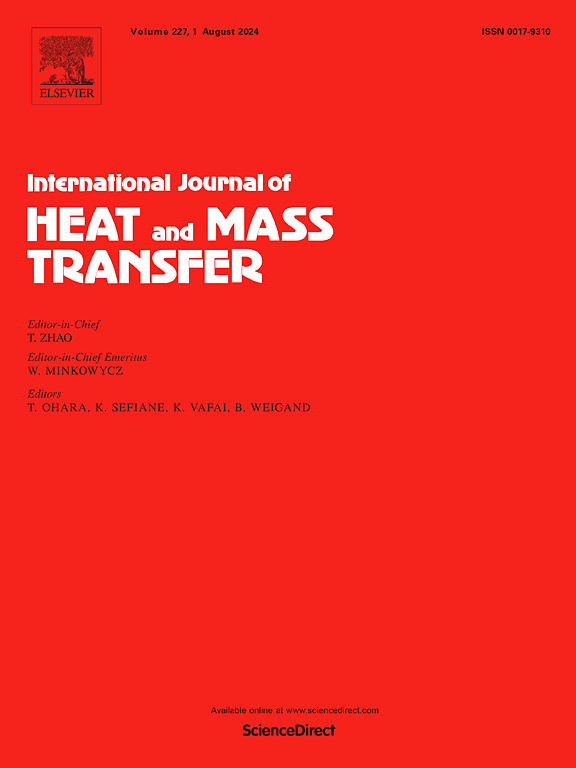电场驱动纳米颗粒重分布自适应控制PCM熔化
IF 5.8
2区 工程技术
Q1 ENGINEERING, MECHANICAL
International Journal of Heat and Mass Transfer
Pub Date : 2025-06-03
DOI:10.1016/j.ijheatmasstransfer.2025.127330
引用次数: 0
摘要
相变材料的高潜热容使其适合于温度调节。然而,它们的低导热率限制了净传热速率。在PCMs中引入纳米颗粒并施加电场是提高其热性能的有效途径。本研究探索了一种耦合纳米粒子(Al₂O₃)-电场策略,以主动控制和增强pcm中的热传递。通过调节纳米颗粒的大小和电场极性来控制纳米颗粒的迁移率和空间分布,从而实现热阻和相变动力学的精确调制。它能有效地自适应控制PCM熔化和加热壁的工作温度。我们的研究结果表明,将纳米颗粒大小从30 nm调整到100 nm可以使作用在液体PCMs中颗粒上的力接近平衡。此外,改变电场极性会影响100 nm纳米颗粒在液相中的空间排列。在负电压下,复合PCM通过降低下腔区的热阻,使壁温降低42.0%,并将温度波动限制在3.3°C。这项工作首次证明,纳米颗粒增强的pcm中的熔化行为可以通过协同电场和热场主动调节,为自适应热管理系统提供了新的范例。本文章由计算机程序翻译,如有差异,请以英文原文为准。
Electric field driven nanoparticle redistribution for adaptive control of PCM melting
High latent heat capacity of Phase Change Materials (PCMs) makes them suitable for temperature regulation. However, their low thermal conductivity limits the net heat transfer rate. Introducing nanoparticles into PCMs and applying electric fields offers an effective way to enhance the thermal performance. The present study explores a coupled nanoparticle (Al₂O₃) - electric field strategy to actively control and enhance thermal transport in PCMs. The nanoparticle mobility and spatial distribution are controlled by tuning nanoparticle size and electric field polarity, enabling precise modulation of thermal resistance and phase transition kinetics. It will adaptively control the PCM melting and the operating temperature of the heating wall effectively. Our findings indicate that adjusting the nanoparticle size from 30 nm to 100 nm enables the forces acting on the particles in the liquid PCMs to approach equilibrium. Additionally, altering the field polarity influences the spatial arrangement of 100 nm nanoparticles within the liquid phase. Under a negative voltage, the composite PCM achieves a 42.0 % reduction in wall temperature and limits temperature fluctuation to just 3.3 °C by lowering thermal resistance in the lower cavity region. This work demonstrates, for the first time, that melting behavior in nanoparticle-enhanced PCMs can be actively tuned via synergistic electric and thermal fields, offering a new paradigm for adaptive thermal management systems.
求助全文
通过发布文献求助,成功后即可免费获取论文全文。
去求助
来源期刊
CiteScore
10.30
自引率
13.50%
发文量
1319
审稿时长
41 days
期刊介绍:
International Journal of Heat and Mass Transfer is the vehicle for the exchange of basic ideas in heat and mass transfer between research workers and engineers throughout the world. It focuses on both analytical and experimental research, with an emphasis on contributions which increase the basic understanding of transfer processes and their application to engineering problems.
Topics include:
-New methods of measuring and/or correlating transport-property data
-Energy engineering
-Environmental applications of heat and/or mass transfer

 求助内容:
求助内容: 应助结果提醒方式:
应助结果提醒方式:


